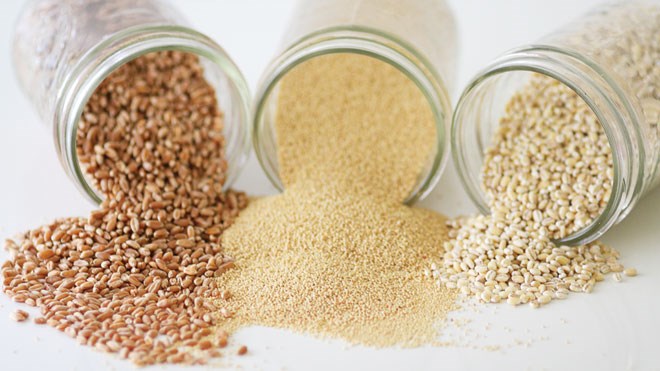Low-fat versus low-carb versus vegan versus gluten-free — there are a lot of diets out there that focus on the parts of your diet that are “evil” and must be eliminated.
From fats to carbohydrates, meat to gluten, you may be feeling like there isn’t much left to eat. While these diets may work for some, most people are unable to sustain the severe restrictions. Instead of focusing on all the “bad” foods we need to avoid, let’s turn our attention to what we can add to our diet to improve it.
In my practice, I have found that there are a few very nutritious foods people are not eating. These are not super foods, magic miracles, belly blasters, tummy trimmers or fat incinerating hyper-metabolic nutrient powerhouses. They’re just foods. And food is good.
Whole grains Challenge yourself to think outside the bread box. If hearing "whole grains" makes you think of frozen pizza with whole wheat crust or Multi Grain Cheerios, then you’re missing the point. By a mile. A whole grain includes the germ, the endosperm and the bran, so it’s higher in fibre, vitamins and minerals. Whole wheat and multigrain products may not actually contain any whole grains (incredibly misleading, I know).
Ancient grains or 12 grains aren’t necessarily whole grains either. Make sure whole grains are first in the ingredient list and look for higher fibre whole grains. Try adding whole oats, brown rice, wild rice, barley, buckwheat, quinoa, rye or bulgar to your diet to increase your intake of whole grains. Many of these grains are cooked in a similar way as rice and can be eaten as a side dish or added to soups and salads.
Leafy Greens I often refer to caesar salad as pseudo-salad. It is creamy dressing (read: fat), cheese (read: fat), and bacon (read: fat) disguised as a salad. Try to eat at least one dark green vegetable every day. A serving of leafy greens is 1 cup raw or ½ cup cooked.
Greens are low in calories, but high in vitamins and fiber so you can load up on them to add volume to your meals. For example, seven cups of spinach contains about 50 calories. So does a single Oreo cookie. Clearly, one will be more filling than the other.
Fish Maybe browsing the seafood counter makes you feel like a fish out of water, but you should make an effort to eat two 75g (2.5oz) servings each week to increase your intake of Vitamin D, iron, and omega-3 fats. These fats may lower the risk of heart disease and some cancers. Fresh, frozen and canned fish are all good choices, but try to avoid breaded and seasoned products. Baking, broiling, or poaching fish are the ticket.
Pulses Pulses include dried beans (navy, black, pinto, kidney, romano), dried peas, lentils and chickpeas. Pulses are a source of fibre, vitamins, and minerals so like many of these other foods they can reduce your risk of developing chronic diseases. I wrote an article about pulses in September that you can check out for more information on NorthernLife.ca.
Nuts and Seeds Don’t be shy! Come out of your shell and add more nuts and seeds to your diet. In a nutshell, they contain fibre and healthy fats that can help reduce your risk of heart disease. Unlike leafy greens, nuts and seeds are energy-dense so a 60mL (¼ cup) serving is enough to reap the benefits without overdoing it.
Avoid honey-roasted or seasoned nuts and seeds as this adds calories and sodium. Choose nuts and seeds that don’t have salt and sugar added to them. You may be familiar with almonds but walnuts, cashews, brazil nuts, hazelnuts, macadamia nuts, and ground flax seeds are nutritious as well. Add nuts and seeds to cereal and salads or enjoy them as part of a snack.
I don’t know who said it first, but it bears repeating: Learn to love food that loves you back. Right now, these might not be the foods that come to mind when you think “delicious,” but with a little time and the right recipes, they can be.
If you’re a parent, set an example for your children. Demonstrate to them that eating a variety of foods is important for health. Eating is social. Ask your friends for recipes, tips, and tricks. You may have to taste something many times before you will like it.
Try these new foods in small amounts with familiar foods that you like and try them prepared different ways before giving up on them. The only thing I know for certain is if you aren’t eating these foods, you should be.
If you have questions about these foods or other nutrition topics, please visit www.eatrightontario.ca or call 1-877-501-5012 to speak to a Registered Dietitian.
Join Sudbury.com+
- Messages
- Post a Listing
- Your Listings
- Your Profile
- Your Subscriptions
- Your Likes
- Your Business
- Support Local News
- Payment History
Sudbury.com+ members
Already a +member?
Not a +member?
Sign up for a Sudbury.com+ account for instant access to upcoming contests, local offers, auctions and so much more.
